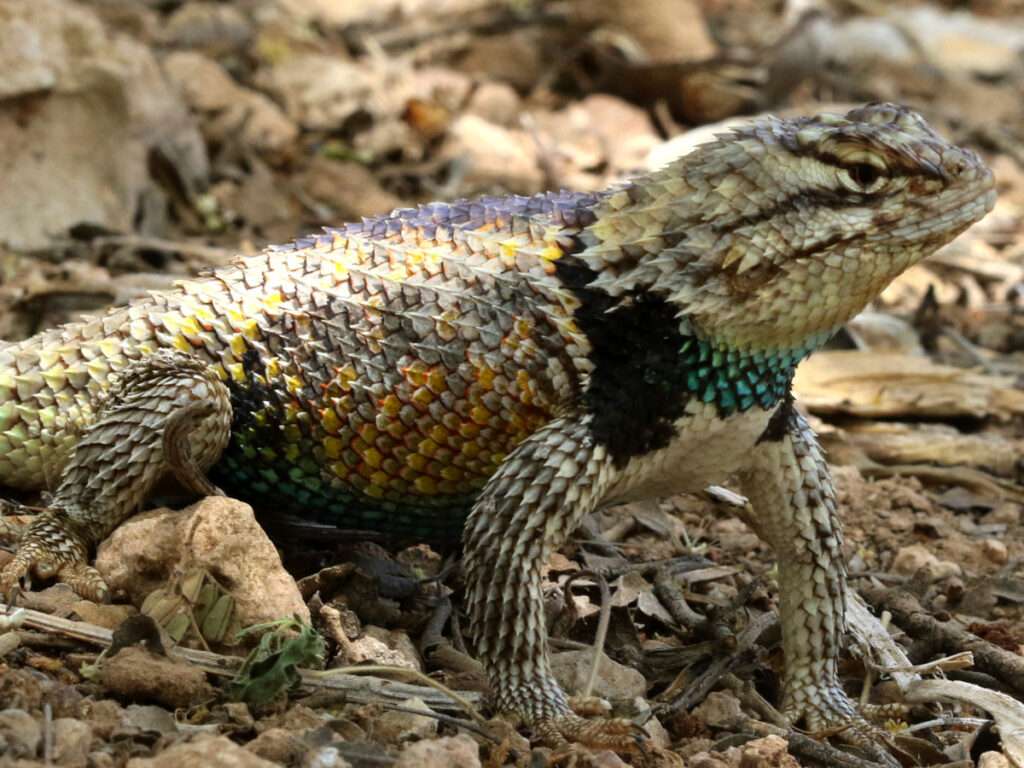
Description:
Scientific name: Sceloporus magister
Life span: 5-6 years
A family of lizards adapted to living in hot deserts includes the Desert Spiny Lizard. The belly, throat, and tails of adult males of this species typically exhibit noticeable blue/violet patches, while the sides and tails are typically green/blue in hue. Females and young individuals lack the blue/violet and green/blue colors, have a significant number of mixed dark patches on their back, and belly regions. On their shoulders, both sexes have triangular brownish-yellow markings.
Native Region/Habitat
In North America, the Sonoran Desert and the Chihuahuan Desert are home to desert spiny lizards. They can be found in Arizona, California, Texas, New Mexico, Nevada, and Utah in the United States. Moreover, they exist in Baja California, Sonora, Chihuahua, Coahuila, and Durango in Mexico.

Behavior:
Arboreal and nocturnal animals predominate among desert spiny lizards. They are loners that want to be alone themselves. Like with many desert reptiles, they often seek refuge during the warmest part of the day in burrows or other suitable covers that give shade. Nevertheless, during the morning hours, they will typically be out basking in the sun on rocks or other hard surface that is in direct sunlight. They go into hibernation in the late fall and the chilly winter, awakening in the spring. As a type of territorial show, desert spiny lizards frequently perform push-ups by pushing their bodies up and down. They also employ camouflage to make themselves less visible to predators.
Care As a pet/In captivity:
Size:
A cage for an adult must be at least 30″ long, 12″ deep, and 12″ high.
Substrate – Sand, finely ground walnut shell, or cage carpet are also acceptable substrates. The likelihood of impaction with walnut shell and sand is the biggest worry. Large substrate consumption by the lizard may result in intestinal obstruction. The safest alternative is cage carpet, although it is challenging to keep clean. The Tye-Dyed Iguana’s preferred substrate is ground walnut.
Temperature:
It should be between 95° and 100°F while a Desert Spiny Lizard is basking. The tank’s cool end can reach a low of 70°F.
Humidity:
Using a spray bottle, some keepers spritz their lizards once or twice a week. The ideal range for humidity is 30% to 50%.
Watering:
Always have a bowl of clean drinking water available. Although desert spiny lizards don’t drink much, it’s still a good idea to provide a water bowl.
Lighting:
This species needs two light bulbs because it is a diurnal species. The heat lamp, which also emits UVA, is one. UVB lighting is the second. On the package of the UVB lamp, UVB will be clearly identified. It is not UVB if the package doesn’t state that it is.
Feeding:
Feed infants and adults every day; some keepers may choose to feed adults only every other day. Sprinkle meals once a day with calcium powder and once a week with a multivitamin. Give them as much food as they’ll consume in 10 minutes. You can leave worms in the food bowl.
Table





